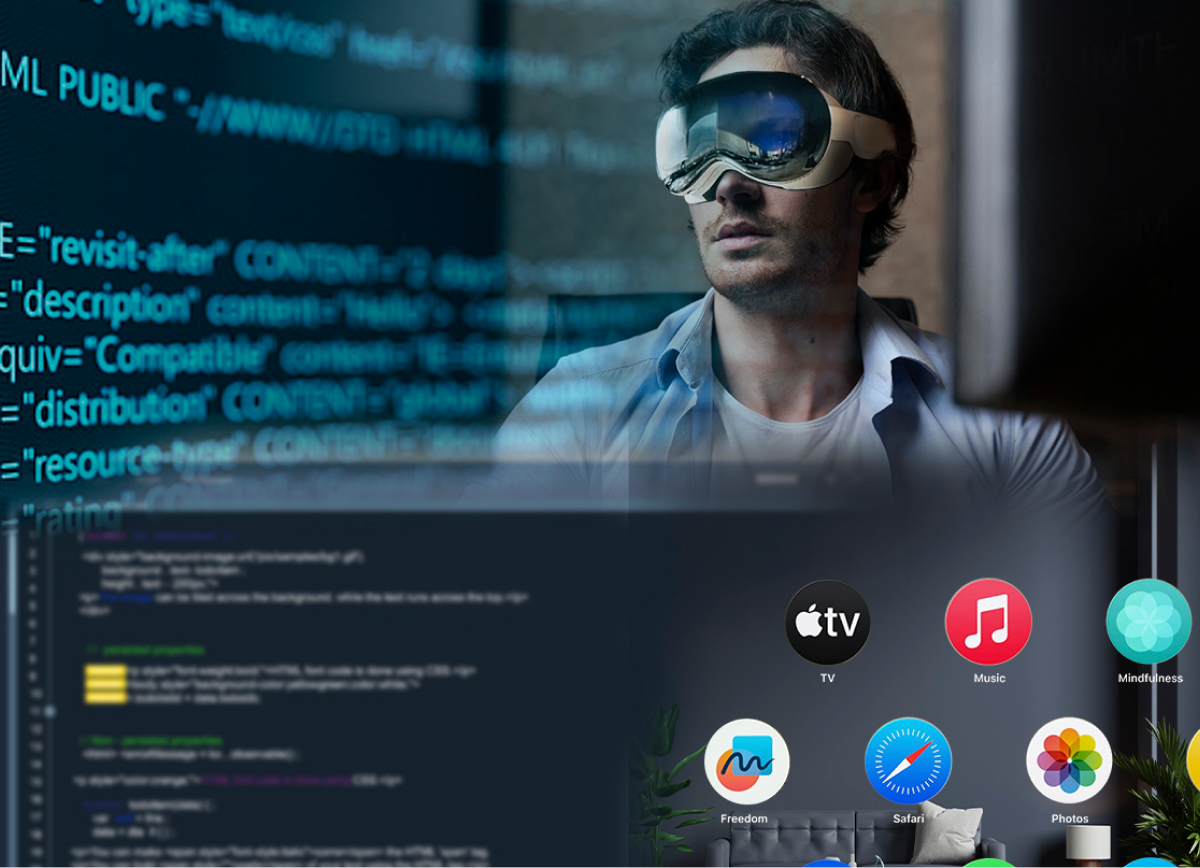
If you’re venturing into the realm of developing applications for Apple Vision Pro, it’s crucial to equip yourself with the right knowledge. In this article, we unravel the key aspects you need to know about the visionOS operating system, the secrets of programming for Apple Vision Pro, and the essential tools required for app development.
visionOS: The Heart of Apple Vision Pro
The foundation of the Vision Pro headset lies in the sophisticated visionOS operating system. Tailored for spatial computing, visionOS seamlessly merges the digital and physical worlds to create captivating experiences. Drawing from Apple’s established operating systems, visionOS introduces a real-time subsystem dedicated to interactive visuals on Vision Pro. This three-dimensional interface liberates apps from conventional display constraints, responding dynamically to natural light.
At launch, visionOS will support a variety of apps, including native Unity apps, Adobe’s Lightroom, Microsoft Office, medical software, and engineering apps. These applications will take advantage of the unique features offered by visionOS to deliver immersive and engaging user experiences.
Programming Secrets for Apple Vision Pro
Programming for Apple Vision Pro involves understanding the concept of spatial computing and the shared space where apps coexist. In this floating virtual reality, users can open windows, each appearing as planes in the virtual environment. These windows support both traditional 2D views and the integration of 3D content. Here are some programming “secrets” for Apple Vision Pro:
- All apps exist in 3D space, even if they are basic 2D apps ported from iOS.
- Consider the Field of View and opt for a landscape screen for user-friendly experiences.
- Prioritize user comfort and posture by placing content at an optimal distance.
- Older UIKit apps can be recompiled for VisionOS, gaining some 3D presence features.
- Be mindful of users’ physical surroundings to ensure a seamless and comfortable experience.
Tools for Apple Vision Pro Development
To initiate the development of applications for Vision Pro, you’ll need a Mac computer running macOS Monterey or a newer version. Additionally, you’ll require the latest release of Xcode and the Vision Pro developer kit.
The development process entails downloading the visionOS SDK and employing familiar tools such as SwiftUI, RealityKit, ARKit, Unity, Reality Composer Pro, and Xcode, which are also utilized for constructing applications on other Apple operating systems.
While it’s feasible to adapt your existing apps for Vision Pro using the visionOS SDK, be prepared for some adjustments in code to accommodate platform differences. Most macOS and iOS apps seamlessly integrate with Vision Pro, preserving their appearance while presenting content within the user’s surroundings as a distinct window.
Now, let’s delve into the essentials for assembling your own Apple Vision Pro development kit:
- SwiftUI: Ideal for creating immersive experiences by overlaying 3D models onto the real world.
- Xcode: Apple’s integrated development environment, vital for app development and testing.
- RealityKit: Exclusively designed for Vision Pro, enabling the creation of lifelike, interactive 3D content.
- ARKit: Apple’s augmented reality framework for overlaying digital content onto the real world.
- Unity: A powerful tool for visually stunning games and Vision Pro app development.
Unity is currently actively developing its SDK to interface with Apple Vision Pro. What’s the catch? Few people know that to develop on Unity, you need not just any Mac, but a Mac with an “M” processor on board!
Here are a few more words about supported versions:
- Unity 2022 LTS (2022.3.191 or newer): Apple Silicon version only.
- Xcode 15.2: Note that beta versions of Xcode are a no-go.
- VisionOS 1.0.3 (21N333) SDK: Beta versions are not supported.
- Unity editor: Apple Silicon Mac and the Apple Silicon macOS build are in; the Intel version is out.
Pay attention to these restrictions during your development journey!
Apple Vision Pro SDK: Empowering Developers
The visionOS Software Development Kit (SDK) is now available, empowering developers to create groundbreaking app experiences for Vision Pro. With tools like Reality Composer Pro, developers can preview and prepare 3D models, animations, and sounds for stunning visuals on Vision Pro. The SDK ensures built-in support for accessibility features, making spatial computing and visionOS apps inclusive and accessible to all users.
As Apple continues to lead the way in spatial computing, developers hold the key to unlocking the full potential of the Vision Pro headset. By understanding the intricacies of visionOS, programming secrets, essential development tools, and the application process for the developer kit, you can position yourself at the forefront of this revolutionary technological landscape.



